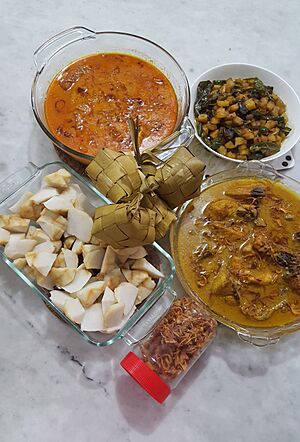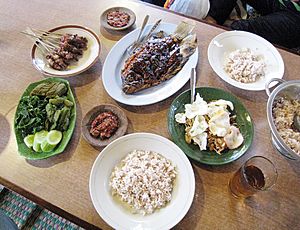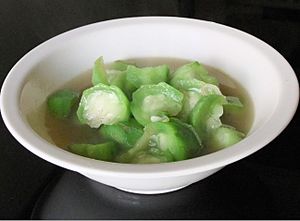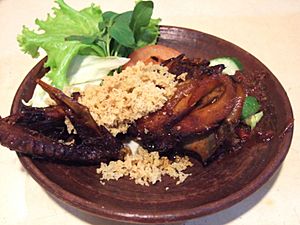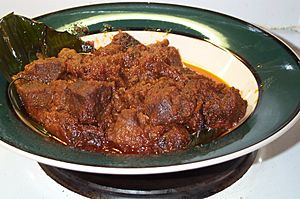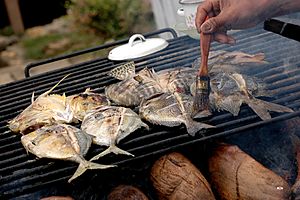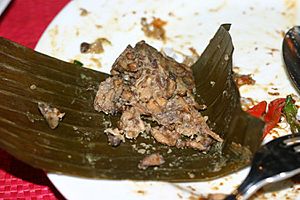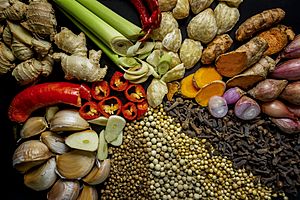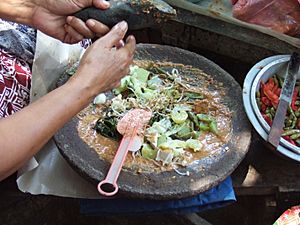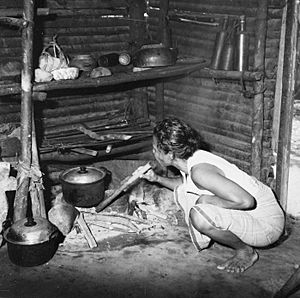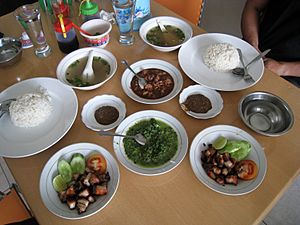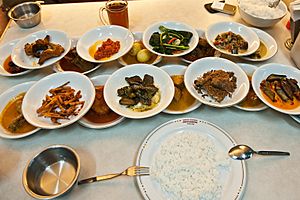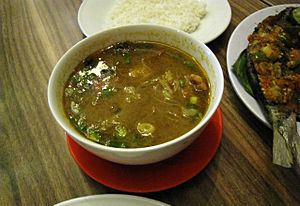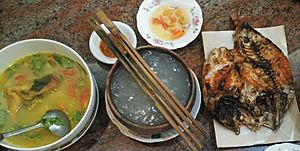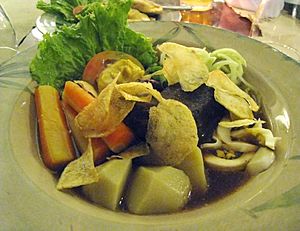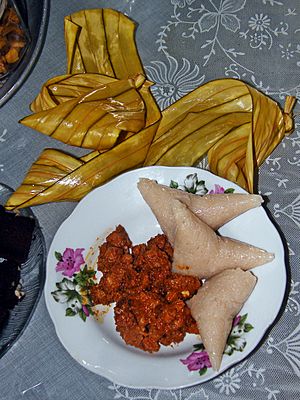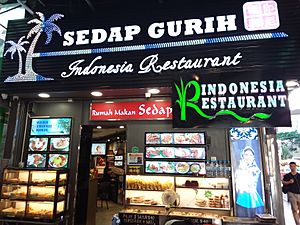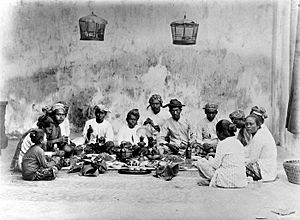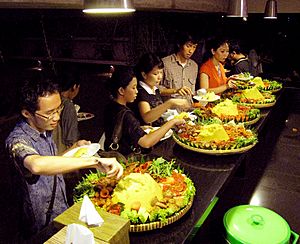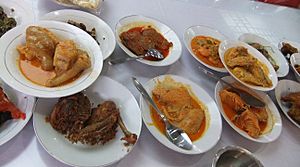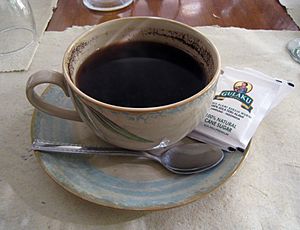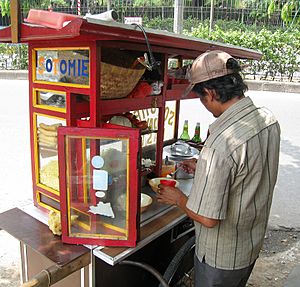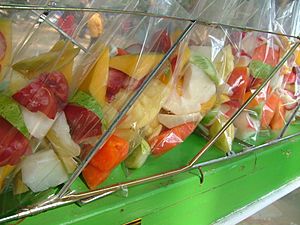Indonesian cuisine facts for kids
Indonesian cuisine is a mix of many different food traditions from the islands of Indonesia. This country has about 6,000 islands where people live, and over 1,300 different ethnic groups! Each group often has its own special way of cooking. Indonesia has around 5,350 traditional recipes, and 30 of them are super important. You can find Indonesian food everywhere, from small local eateries called warung to fancy restaurants.
Indonesian food changes a lot from one region to another. For example, food from Sumatra often has flavors from the Middle East and India. You'll find curried meats and vegetables like gulai. But Javanese cuisine is mostly local, with some hints of Chinese flavors. The food in Eastern Indonesia is similar to what you'd find in Polynesia and Melanesia. Some Chinese foods like noodles, meatballs, and spring rolls are now completely part of Indonesian cooking.
Indonesia has always been a trading hub because of its location and natural resources. This means its cooking techniques and ingredients were influenced by India, the Middle East, China, and Europe. Traders from Spain and Portugal brought new foods from the Americas even before the Dutch came. The Moluccas, known as the "Spice Islands," also shared their native spices like cloves and nutmeg with Indonesia and the world.
Indonesian food often has many different and strong flavors. It's usually described as savory, hot, and spicy. You'll also find combinations of sweet, salty, sour, and bitter tastes. Most Indonesians love hot and spicy food. That's why sambal, a hot chili sauce, is a must-have at every meal. It's made with chilies and other ingredients like shrimp paste or shallots. The main ways Indonesians cook are frying, grilling, roasting, dry roasting, sautéing, boiling, and steaming.
Some famous Indonesian dishes are nasi goreng (fried rice), gado-gado (vegetable salad with peanut sauce), satay (grilled skewers), and soto (soup). These are found everywhere and are considered national dishes. In 2014, the Indonesian Ministry of Tourism chose tumpeng as the official national dish. It represents all the different food traditions of Indonesia. Later, in 2018, the ministry picked five national dishes: soto, rendang, satay, nasi goreng, and gado-gado.
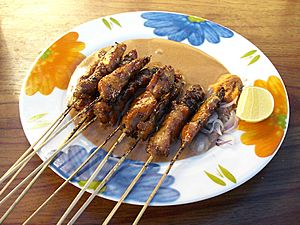
Today, some popular Indonesian dishes are also common in nearby countries like Malaysia and Singapore. These include satay, beef rendang, and sambal. Dishes made from soy, like tofu and tempeh, are also very popular. Tempeh is thought to be a Javanese invention. It's a fermented soy-based food. Another fermented food is oncom, which is similar to tempeh but uses different ingredients and is popular in West Java.
Contents
- History of Indonesian Cuisine
- How Indonesians Eat and Serve Food
- Main Foods (Staples)
- Vegetables in Indonesian Cooking
- Meat and Fish in Indonesian Cuisine
- Spices and Flavorings
- Cooking Methods in Indonesia
- Indonesia's National Dishes
- Regional Dishes: A Taste of Indonesia's Diversity
- Jakarta: A Mix of Flavors
- West Java: Fresh and Spicy
- Central Java: Sweet and Savory
- East Java: Spicier Flavors
- Madura: Salty and Unique Satay
- Bali: Rich and Spicy
- Aceh: Indian and Arab Flavors
- North Sumatra: Unique Meats
- West Sumatra: Rendang and Gulai
- East Sumatra: Malay Flavors
- South Sumatra: Pempek and Pindang
- North Sulawesi: Spicy and Exotic Meats
- South Sulawesi: Seafood and Soups
- Nusa Tenggara: Dry Climate Foods
- Maluku and Papua: Sago and Seafood
- Foreign Influences on Indonesian Cuisine
- Indonesian Food Around the World
- Meal Times in Indonesia
- Feasts and Special Meals
- Drinks in Indonesia
- Where to Eat in Indonesia
- Snacks: Sweet and Savory Bites
- Fruits: Tropical Delights
- See also
History of Indonesian Cuisine
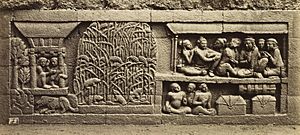
Indonesian food has a long history, but most of it wasn't written down. It was passed on through local traditions. However, Javanese cuisine has some well-documented food history. The food traditions range from ancient bakar batu (stone-grilled yams and boar) of Papuan tribes to modern Indonesian fusion dishes. Indonesia's many ethnic groups have created a mix of local Javanese, Sundanese, Balinese, Minang, Malay, and other native foods. These have been blended with flavors from Indian traders, Chinese migrants, and Dutch colonizers over centuries.
Rice has always been a main food for Indonesians. Old carvings from the 9th century Borobudur and Prambanan temples show rice farming in ancient Java. Some old dishes are mentioned in Javanese writings. For example, texts from the Medang Mataram era (8th-10th century) mention hadaŋan haraŋ (minced water buffalo satay, like today's Balinese sate lilit). They also mention kuluban (boiled vegetables with spices, similar to urap).
By the 13th to 15th centuries, Indonesian coastal areas started to get food influences from India and the Middle East. This is why you see curry-like recipes in these regions. This was especially true in Aceh, Minangkabau lands of West Sumatra, and Malay ports. These areas show typical Indian food influences like kare (curry), roti cane, and gulai. This also happened as people adopted the Islamic faith, which led to halal food rules that forbid pork. However, people living inland, like the Bataks and Dayaks, kept their older traditions. They still eat bushmeat, pork, and blood in their daily meals.

Chinese immigrants came to Indonesia as early as the Majapahit period (around the 15th century) and more during Dutch rule. They brought the stir-frying cooking method, which uses a Chinese wok and a little oil. They also introduced new Chinese foods like soy sauce, noodles, and tofu. Making tofu then led to the discovery of tempeh (fermented soybean cake). The first mention of tempeh was in 1815 in a Javanese book called Serat Centhini.
The search for spices during the Age of Exploration brought European traders to Indonesia. Later, in the 19th century, the Dutch East Indies became a colony. European food, especially from Portugal and the Netherlands, introduced new cooking methods. These included bread-making, pastries, cookies, and cakes.
How Indonesians Eat and Serve Food
Traditional Indonesian meals usually have steamed rice as the main part. Around it, you'll find vegetables, soup, and meat or fish side dishes. In a family meal, everyone gathers around a table with steamed rice and several other dishes. Each dish is in its own large plate or bowl. Each dish has its own serving spoon. People use these spoons to take food from the communal plate to their own plate.
Everyone has their own plate, which they first fill with steamed rice. Usually, the oldest family member or the husband starts the meal. Then, everyone else helps themselves to the dishes. They take some food from the communal plates onto their own plates.
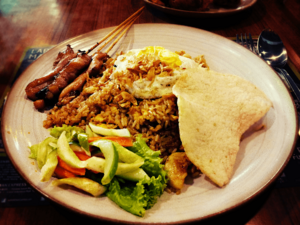
On their personal plate, the steamed rice will be surrounded by two, three, or more dishes. These include vegetables, fish or meat, fried dishes, sambal, and krupuk (crackers). In Indonesia, it's fine to mix different flavored dishes on one plate while eating. This is common with nasi campur (mixed rice) or nasi Padang (Padang-style rice). Soupy dishes might be served in a separate small bowl.
Indonesian meals are usually eaten with a spoon in the right hand and a fork in the left. The fork is used to push food onto the spoon. Unlike in Europe, knives are not used at the dining table. So, most ingredients like vegetables and meat are already cut into bite-sized pieces before cooking.
However, in many parts of Indonesia, like West Java and West Sumatra, people often eat with their bare hands. In restaurants or homes where people eat with their hands, like seafood stalls or traditional Sundanese and Minangkabau restaurants, kobokan is usually served. Kobokan is a bowl of tap water with a slice of lime. It's not for drinking, but for washing hands before and after eating. Eating with chopsticks is mostly seen in places serving Indonesian versions of Chinese food, like bakmie (noodles) or mie ayam (chicken noodles).
Main Foods (Staples)
Rice: The Heart of Indonesian Meals
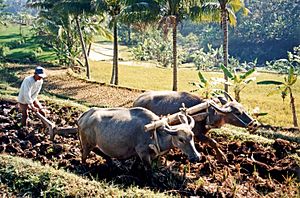
Rice is a main food for everyone in Indonesia today. It's super important in Indonesian culture. It shapes the land, is sold in markets, and is served in most meals, both savory and sweet. The importance of rice is shown by Dewi Sri, the rice goddess in ancient Java and Bali. Rice harvest festivals, like Seren Taun, were traditionally celebrated.
Rice is usually eaten plain with side dishes of protein and vegetables. It's also used to make nasi uduk (rice cooked in coconut milk), nasi kuning (rice cooked with coconut milk and turmeric), ketupat (rice steamed in woven coconut leaves), and lontong (rice steamed in banana leaves). Rice crackers like intip or rengginang are also popular. Nasi goreng (fried rice) is everywhere in Indonesia and is considered a national dish.

Rice became a main food as people learned to grow it or buy it. Evidence of wild rice in Sulawesi dates back to 3000 BCE. The oldest signs of farming come from 8th-century stone carvings in Java. These show kings collecting taxes in rice. The carvings on the 9th-century Borobudur and Prambanan temples show rice farming, rice barns, and even mice infesting rice fields.
Wheat: Noodles and Bread
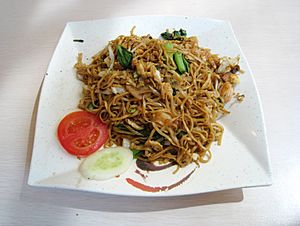
Wheat isn't originally from Indonesia. But through imports and foreign influences, especially from China and the Netherlands, Indonesians started to like wheat-based foods. These include Chinese noodles, Indian roti, and Dutch bread. Chinese people in Indonesia also eat noodles, bakpao (steamed buns), and cakwe (fried dough sticks) as main foods. However, in Java and Sumatra, where rice is king, noodles are sometimes eaten as side dishes with rice. Chinese buns and cakwe are often snacks. Europeans, especially the Portuguese and Dutch, brought bread and various baked goods. These are now popular for a quick breakfast.
Indonesian wheat use grew a lot after instant noodles became popular in the 1970s. Since then, Indonesia has become one of the world's biggest makers and eaters of instant noodles. It's the second-largest instant noodle market after China. Today, instant noodles are a quick and easy meal in many Indonesian homes. Brands like Indomie are very well-known.
Other Important Foods
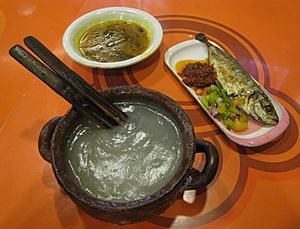
Other main foods in Indonesia include starchy tubers like yams, sweet potato, potato, taro, and cassava. Starchy fruits like breadfruit and jackfruit, and grains like maize (corn), are also eaten. A sago porridge called papeda is a main food, especially in Maluku and Papua. Sago is often mixed with water and cooked as a simple pancake. People in eastern Indonesia also eat wild tubers as main foods.
Many tubers like talas (a type of taro) and breadfruit are native to Indonesia. Others came from different places. Yams came from Africa. Potatoes, sweet potatoes, cassava, and maize came from the Americas through Spanish influence and reached Java in the 17th century. Cassava is usually boiled, steamed, fried, or made into a popular snack called kripik singkong (cassava crackers). Dried cassava, called tiwul, is an alternative main food in dry areas of Java. Corn is eaten in drier regions like Madura and islands east of the Wallace Line.
Vegetables in Indonesian Cooking
Many leafy vegetables are used in Indonesian cooking. These include kangkung (water spinach), spinach, genjer, melinjo, papaya leaves, and cassava leaves. They are often stir-fried with garlic. Spinach and corn are used in a simple clear vegetable soup called sayur bayam bening. Other vegetables like calabash, chayote, kelor, yardlong bean, eggplant, and gambas are cut and used in stir-fries, curries, and soups like sayur asem (sour vegetable soup) or sayur lodeh (vegetable soup with coconut milk). Tumis kangkung (stir-fried water spinach) is a very popular dish.
Vegetables like winged bean, tomato, cucumber, and small bitter melon are often eaten raw, like in lalab. The large bitter melon is usually boiled. Kecombrang (torch ginger) and papaya flower buds are common Indonesian vegetables. Urap is a mix of seasoned shredded coconut with vegetables. Gado-gado and pecel are salads of boiled vegetables with a spicy peanut sauce. Karedok is a raw version of these salads.
Vegetarian Options in Indonesia
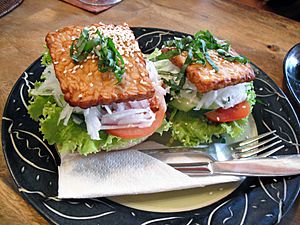
Vegetarianism is well-represented in Indonesia. There are many vegetarian dishes and meat substitutes. Dishes like gado-gado, karedok, ketoprak, tauge goreng, pecel, urap, rujak, and asinan are vegetarian. However, some dishes with peanut sauce, like gado-gado, might have a tiny bit of shrimp paste called "terasi" for flavor. Shrimp paste is also often used in sambal chili paste served with fresh vegetables. Fermented soy products like tempeh, "tahu" (tofu), and oncom are common meat substitutes and a source of plant protein. In modern cooking, tempeh is even used to make tempeh burgers.
Most Indonesians don't follow strict vegetarian diets. They might eat vegetarian dishes because they like the taste, for health reasons, or because they are cheaper. However, a small number of Indonesian Buddhists are strict vegetarians for religious reasons.
Meat and Fish in Indonesian Cuisine
The main animal protein sources in Indonesia are mostly poultry and fish. Meats like beef, water buffalo, goat, and mutton are also common in markets.
Poultry Dishes
The most common poultry eaten is chicken. Duck is eaten less often. Pigeon, quail, and wild swamp birds are also consumed. Traditionally, Indonesians raise free-range chickens in villages, known as ayam kampung (village chicken). These chickens are thinner and their meat is a bit firmer than farmed chickens. Many recipes for ayam goreng (fried chicken) and ayam bakar (grilled chicken) are found all over Indonesia. Besides frying or grilling, chicken can be cooked in soup, like sup ayam and soto ayam, or in coconut milk as opor ayam. Chicken satay is also very common. It's barbecued meat on a skewer served with peanut sauce.
Meat Dishes
Beef and goat meat are the most eaten meats in Indonesia. Kerbau (water buffalo) and sheep are eaten less. Water buffalo are more often used for plowing rice fields, and sheep are kept for wool or for traditional ram fighting. Since most Indonesians are Muslim, they follow halal food rules, which forbid eating pork. In parts of Indonesia with many non-Muslims, boar and pork are commonly eaten. You can find non-halal meat dishes in provinces like Bali, North Sumatra, North Sulawesi, and in Chinatowns in big cities. Most restaurants in Indonesia have halal signs to show they don't serve pork or use lard.
Meat can be cooked with rich spices and coconut milk, like beef, goat, or lamb rendang. It can be skewered, seasoned, and grilled as satay. Or it can be sliced and cooked in a rich broth soup as soto. Mutton and various offals (organ meats) can be used for soto soup or gulai curry. In Bali, where most people are Hindu, babi guling (roasted pig) is popular. The Batak people of North Sumatra have babi panggang, a similar dish. Wild boar is also eaten in Papua. Meat can also be thinly sliced and dried as dendeng (jerky), or made into abon (meat floss). Dendeng celeng is Indonesian dried boar meat. Cooked rabbits are also eaten in Indonesia's mountainous regions.
Some game meats like venison might be sold in certain areas. In Kalimantan, West Nusa Tenggara, East Nusa Tenggara, and Papua, deer meat is found, usually from hunting. Other unusual meats include frog legs and softshell turtle in Chinese Indonesian and Javanese cooking. Horse meat is eaten in Yogyakarta and West Nusa Tenggara. Turtle meat is eaten in Bali and Eastern Indonesia. Snake, biawak (monitor lizard), paniki (fruit bats), dog meat, cat meat, and field rats are eaten in Minahasan cuisine in North Sulawesi.
Fish and Seafood
Indonesia is an island nation, so seafood is plentiful. It's commonly eaten, especially by people living in coastal areas. Fish is very popular in eastern Indonesia, like Sulawesi and Maluku, where many people are fishermen. These areas have a vast sea with many different kinds of seafood. Popular seafood in Indonesian cuisine includes skipjack tuna, tuna, mackerel, pomfret, wahoo, milkfish, trevally, rabbitfish, garoupa, red snapper, anchovy, swordfish, shark, stingray, squid or cuttlefish, shrimp, crab, and mussel. Seafood is usually grilled, boiled, or fried. Ikan bakar (grilled fish) is a popular dish found throughout Indonesia. Salted fish is also common in Indonesian markets.
Freshwater fish are found inland or in areas with large rivers or lakes. They are popular in Sundanese cuisine of West Java, from Lake Toba in North Sumatra, or from large rivers in Riau, Jambi, South Sumatra, and Kalimantan. Popular freshwater fish include carp, gourami, catfish, pangasius, snakehead, and Nile tilapia.
Insects as Food
Unlike Thailand, eating insects is not very popular or widely available as street food in Indonesia. In Java, locals do catch and sell certain insects, usually fresh or alive as bird feed. However, some Indonesian cultures traditionally eat insects. These include grasshoppers, crickets, termites, and the larvae of sago palm weevils, bees, and dragonflys. In Java and Kalimantan, grasshoppers and crickets are often lightly battered and deep-fried as crispy snacks. Smaller grasshoppers, crickets, and termites might be made into rempeyek crackers. During the rainy season, flying termites are common. Locals often trap them, remove their wings, and roast them for a protein-rich snack. In Banyuwangi, East Java, there's a dish called botok tawon (honeybee botok). It's beehives with bee larvae, seasoned with shredded coconut and spices, wrapped in banana leaf, and steamed. Dayak tribes in Kalimantan, and tribes in Maluku and Papua, eat ulat sagu (sago palm weevil larvae). These protein-rich larvae are a delicacy in Papua and are often roasted before eating. Locals might also eat them raw. In Bali, dragonflies are processed into pepes (steamed in banana leaves).
Spices and Flavorings
"Rempah" is the Indonesian word for spice. "Bumbu" means a spice mixture or seasoning. The Maluku islands, known as the "Spice Islands," introduced their native spices to the world. Spices like nutmeg, clove, pandan leaves, keluwak, and galangal are native to Indonesia. It's believed that black pepper, turmeric, lemongrass, shallot, cinnamon, candlenut, coriander, and tamarind came from India. Ginger, scallions, and garlic came from China. These spices from mainland Asia were introduced long ago and are now key ingredients in Indonesian food.
In ancient times, the kingdom of Sunda and later the sultanate of Banten were major producers of black pepper. The sea empires of Srivijaya and Majapahit also profited from the spice trade between the spice islands, China, and India. Later, the Dutch East India Company controlled this trade.
Sambal: The Spicy Kick
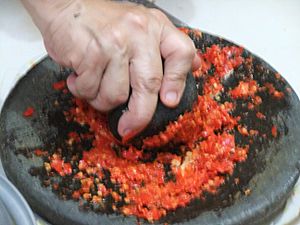
Indonesians love hot and spicy food. This love grew even more when the Spanish brought chili peppers from the Americas in the 16th century. After that, hot and spicy sambals became a very important part of Indonesian cooking.
Indonesia has perhaps the most types of sambal, with as many as 300 varieties. The spiciness ranges from mild to very hot. Sambal has many versions across Indonesia. Some of the most popular are sambal terasi (with fermented shrimp paste) and sambal mangga muda (unripe mango sambal). Sambal terasi is a mix of chilies, strong fermented shrimp paste (terasi), tangy lime juice, sugar, and salt, all pounded together. Dabu-dabu is a North Sulawesi style of sambal with chopped fresh tomato, chili, and lime juice.
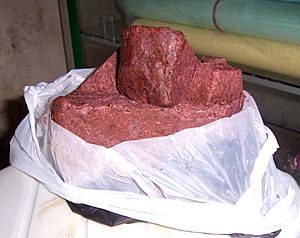
Sambal, especially sambal ulek or sambal terasi, can also be a base ingredient for many dishes. Examples include sambal raja (a dish from Kutai), terong balado (eggplant with chili), and dendeng balado (jerky with chili).
Sauces and Seasonings
Soy sauce is also an important flavoring in Indonesian food. Kecap asin (salty soy sauce) came from Chinese cooking. But Indonesians made their own kecap manis (sweet soy sauce) by adding a lot of palm sugar to soy sauce. Sweet soy sauce is a key marinade for grilled meat and fish, like satay. It's also important for semur, an Indonesian stew.
Peanut Sauce: A Signature Flavor
One special thing about Indonesian cuisine is the wide use of peanuts. They are in many famous dishes like satay, gado-gado, karedok, ketoprak, and pecel. All these dishes use a lot of bumbu kacang (peanut sauce) for flavor. Gado-gado and Satay are even considered Indonesian national dishes.
Peanuts came from Mexico and were brought by Portuguese and Spanish merchants in the 16th century. Peanuts grew well in Southeast Asia's tropical climate. Today, you'll find them roasted and finely chopped in many recipes. Whole, halved, or crushed peanuts are used to decorate dishes. They are also used in marinades and dipping sauces like sambal kacang (ground chilies and fried peanuts) for otak-otak (fish cake) or ketan (sticky rice). Peanut oil is one of the most common cooking oils in Indonesia.
Bumbu kacang (peanut sauce) is a complex, earthy seasoning. It should have a good balance of savory, sweet, sour, and spicy flavors. These come from ingredients like fried peanuts, gula jawa (coconut sugar), garlic, shallots, ginger, tamarind, lemon juice, lemongrass, salt, chili, peppercorns, and sweet soy sauce. These are ground together and mixed with water. The secret to good peanut sauce is "not too thick and not too watery." Indonesian peanut sauce is usually less sweet than the Thai version. Gado-gado is a popular dish known for its peanut sauce and is eaten all over Indonesia.
Coconut Milk: Creamy Goodness
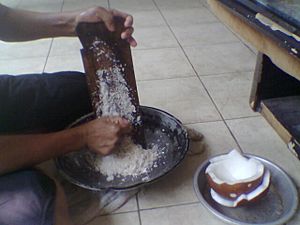
Shredding coconut flesh to make coconut milk.
|
Coconuts are plentiful in tropical Indonesia. For a long time, Indonesians have found many uses for this plant. Using coconut milk in dishes across the islands is another common feature of Indonesian food. It's used in savory dishes like rendang, soto, gulai, mie koclok, sayur lodeh, gudeg, and opor ayam. It's also in desserts like es cendol and es doger. Soto is found everywhere in Indonesia and is considered one of its national dishes.
Coconut milk is also used in Indian, Samoan, Thai, Malaysian, Filipino, and Brazilian foods. But its use is very widespread in Indonesia, especially in Minangkabau cuisine. However, in Minahasan (North Sulawesi) cuisine, coconut milk is generally not used, except in cakes and desserts like klappertaart.

In Indonesian cooking, there are two types of coconut milk: thin and thick. The difference depends on the water and oil content. Thin coconut milk is usually for soups like sayur lodeh and soto. The thicker kind is used for rendang and desserts. You can make it from freshly shredded coconut meat or buy it processed in cartons.
After the milk is taken from shredded coconut, the leftover coconut flesh (ampas kelapa) can still be used. It's used in urap, which is seasoned shredded coconut mixed with vegetables. Leftover shredded coconut can also be cooked and seasoned to make serundeng, a sweet and spicy finely shredded coconut that's almost powdery. Kerisik paste, used to thicken rendang, is another use of coconut flesh. Serundeng can be mixed with meat in dishes like serundeng daging (beef serundeng) or sprinkled on top of other dishes. An example of heavy coconut use is Burasa from Makassar. It's rice wrapped in banana leaf, cooked with coconut milk, and sprinkled with powdered coconut similar to serundeng.
Cooking Methods in Indonesia
Most Indonesian dishes are named after their main ingredients and how they are cooked. For example, ayam goreng means ayam (chicken) and goreng (frying), so it's fried chicken. Mie goreng is fried noodles. Ikan bakar is grilled fish. Udang rebus is boiled shrimp. Babi panggang is roasted pork. Tumis kangkung is stir-fried water spinach.
Common cooking methods in Indonesian kitchens are goreng (frying or deep frying), tumis (stir frying), and sangrai (sautéing without oil). Roasting methods include bakar (grilling), usually with charcoal or firewood. Panggang (baking/roasting) usually means baking in an oven. Other methods are rebus (boiling), kukus (steaming), and asap/salai (smoking).
Cooking can use a strong fire or a small fire for slow cooking. Nasi goreng usually needs a strong fire. But real rendang needs a small fire for slow cooking beef, spices, and coconut milk until the meat is caramelized and the liquid is gone. Traditional Indonesian dapur (kitchen) often uses a firewood stove. Modern homes use liquefied petroleum gas or electric stoves. Ingredients can be cut, sliced, or ground into a paste. Cooking tools include wajan (wok), penggorengan (frying pan), panci (cauldron), knives, spoons, forks, parutan (shredder), and cobek and ulekan (stone mortar and pestle). Traditionally, Indonesians use a stone mortar and pestle to grind spices. Today, most homes use a blender or food processor. Traditional Indonesian cooking wares are made from stone, earthenware pottery, wood, and woven bamboo. Modern ones use metals, ceramics, plastics, and glass.
Indonesia's National Dishes
When Indonesia first became independent, the very popular nasi goreng (fried rice) was unofficially considered the national dish. It was simple and versatile, making it a favorite in Indonesian homes. It was even served at the Indonesian pavilion at the 1964 New York World's Fair. However, other popular dishes like satay, soto, and gado-gado were also strong contenders.
In 2014, the Indonesian Ministry of Tourism chose tumpeng as an official Indonesian national dish. Tumpeng refers to a cone-shaped mound of rice in the center. The dishes around it can be any of Indonesia's many foods. This made it a perfect national dish to show Indonesia's diverse food traditions. Later, in 2018, the same ministry added five more national dishes: soto, satay, nasi goreng, rendang, and gado-gado.
Satay and soto are great choices because they are loved by many different ethnic groups of Indonesia. These dishes have been adapted into many different recipes across the country. For example, there are many types of satay and soto from Sumatra to Eastern Indonesia. Each culture, ethnic group, or even city has its own version, based on their traditions, creativity, local tastes, and available ingredients.
Regional Dishes: A Taste of Indonesia's Diversity
Jakarta: A Mix of Flavors
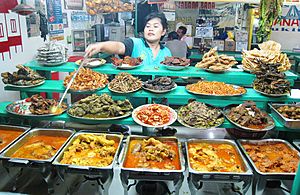
Betawi cuisine from Jakarta is diverse and combines flavors from Chinese, Malay, Sundanese, Arab, Indian, and European cooking. Popular Betawi dishes include nasi uduk (coconut rice), sayur asem (sweet and sour vegetable soup), asinan (pickled vegetable salad), gado-gado (vegetable salad with peanut sauce), ketoprak (vegetables, tofu, noodles, and rice cake in peanut sauce), and kerak telor (spiced coconut omelette). Betawi cuisine is a mix of cultures, similar to Peranakan cuisine.
West Java: Fresh and Spicy
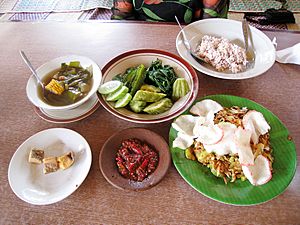
A special dish from Sunda (West Java) is karedok. It's a fresh salad made with long beans, bean sprouts, and cucumber with a spicy peanut sauce. Lalab (fresh vegetables served with spicy sambal dipping sauce) is found everywhere in Sundanese homes and restaurants. Other Sundanese dishes include mie kocok (beef and egg noodle soup) and Soto Bandung (beef and vegetable soup with daikon and lemongrass). A popular street food is kupat tahu (pressed rice, bean sprouts, and tofu with soy and peanut sauce). Colenak (roasted fermented cassava with sweet coconut sauce) and ulen (roasted sticky rice with peanut sauce) are usually eaten warm.
Central Java: Sweet and Savory

The food of Central Java is known for being sweet. Gudeg, a curry made from jackfruit, is especially sweet. The city of Yogyakarta is famous for its ayam goreng (fried chicken) and klepon (green rice-flour balls with palm sugar filling). Surakarta's (Solo) specialties include Nasi liwet (rice with coconut milk, unripe papaya, garlic, and shallots, served with chicken or egg) and serabi (coconut milk pancakes with chocolate, banana, or jackfruit toppings). Other Central Javanese specialties are pecel (peanut sauce with spinach and bean sprouts) and opor ayam (braised chicken in coconut sauce).
East Java: Spicier Flavors
The food of East Java is similar to Central Java but tends to be less sweet and spicier. Fish and seafood products are widely used, like terasi (dried shrimp paste) and petis udang (shrimp paste). Some popular foods are lontong kupang (tiny clams soup with rice cakes), lontong balap (bean sprouts and tofu with rice cakes), sate klopo (coconut beef satay), pecel lele (deep-fried catfish with rice and sambal), and rawon (dark beef soup). Food from Malang includes bakwan Malang (meatball soup with wonton and noodles).
Madura: Salty and Unique Satay
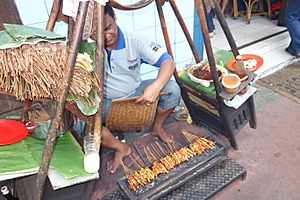
Madura is an island off Java's northeast coast. Like East Javanese foods, Madura foods use petis, but theirs is petis ikan (fish paste) instead of shrimp. The Madura style satay is probably the most popular satay in Indonesia. Some popular dishes are sate ayam Madura (chicken satay with peanut sauce) and soto Madura (beef soup). There's also a mutton version of Madura satay. Sup Kambing (mutton soup) is also popular. As a major salt producer, Madura dishes are often saltier than other East Javanese foods.
Bali: Rich and Spicy
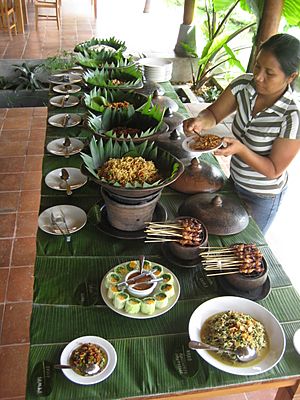
Balinese cuisine includes lawar (chopped coconut, garlic, chili, with pork or chicken meat and blood). Bebek betutu is duck stuffed with spices, wrapped in banana leaves and coconut husks, and cooked in a pit of embers. Balinese sate, called sate lilit, is made from spiced minced meat pressed onto skewers, often made from lemongrass sticks. Babi guling is a spit-roasted pig stuffed with chili, turmeric, garlic, and ginger. Basa gede or basa rajang is a spice paste that's a basic ingredient in many Balinese dishes.
Aceh: Indian and Arab Flavors
Arab, Persian, and Indian traders influenced food in Aceh, though the flavors have changed over time. Examples include curry dishes called kare or gulai. These are rich, coconut-based dishes traditionally made with beef, goat, fish, or poultry. They are now also made with tofu, vegetables, and jackfruit. Popular Aceh foods include roti cane, mie aceh (Aceh noodles), and nasi gurih (savory rice).
North Sumatra: Unique Meats
Batak people use either pork or even dog to make saksang. Another Batak pork specialty is babi panggang, where the meat is boiled in vinegar and pig blood before being roasted. Another Batak dish, ayam namargota, is chicken cooked in spices and blood. A notable Batak dish is arsik, carp fish cooked with spices and herbs. Lada rimba is a strong pepper used by Bataks.
West Sumatra: Rendang and Gulai
Buffaloes are a symbol of West Sumatra and are used in rendang. This is a rich and spicy buffalo meat or beef dish, and it's the signature dish of Minangkabau culture. In 2017, rendang was chosen as the "World's Most Delicious Food" by CNN Travel readers. Padang food comes from West Sumatra and has perhaps the most types of gulai, a type of curried meat, offal, fish, or vegetables. Padang favorites include asam padeh (sour and spicy fish stew), sate Padang (Padang satay), and soto Padang (Padang soto).
Traditionally, Minangkabau people are known for their merantau (migrating) culture, and they are good at running restaurants. As a result, Padang food restaurants are found all over Indonesia and neighboring countries. This makes it probably the most popular regional dish in Indonesia.
East Sumatra: Malay Flavors
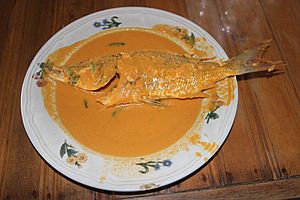
The cuisine of Sumatra's east coast refers to the food traditions of ethnic Malays in Indonesian provinces facing the Strait of Malacca. This includes Riau, Riau Islands, Jambi provinces, and coastal North Sumatra. Because of close family ties and closeness to Malaysian Malays, many dishes are shared between the two countries. For example, nasi lemak, Malaysia's national dish, and nasi ulam are considered native dishes in Riau and Jambi. Malay cuisine also shares many similarities with nearby Minangkabau cuisine, like gulai, asam pedas, pindang, kari, lemang, and rendang. This is because the Minangkabau people are culturally close to the Malays. Tempoyak (fermented durian sauce) and sambal belacan are common sauces in both Sumatra and the Malay Peninsula. Seafood dishes are popular in the Riau Islands province. Freshwater fish like patin, catfish, carp, and gourami are popular in Riau and Jambi. Gulai ikan patin is a signature dish of Pekanbaru.
South Sumatra: Pempek and Pindang

The city of Palembang is the food center of South Sumatra. It's famous for its pempek, a deep-fried fish and sago dumpling. Pempek is served with a special kuah cuko, a sweet, sour, and spicy sauce made from palm sugar, chili, tamarind, and vinegar. Pempek dishes also include tekwan (soup with pempek dumplings, mushrooms, vegetables, and shrimp). Mie celor (noodles with egg in coconut milk and dried shrimp) is a Palembang specialty.
Palembang's food shows influences from local Malay tastes, Chinese, and Javanese cooking. Pempek is said to be influenced by Chinese fish cakes. The preference for mild sweetness is said to be from Javanese influence. South Sumatra is home to pindang, a sweet, sour, and spicy fish soup made from soy sauce and tamarind. Pindang dishes usually use freshwater fish or seafood. Ikan brengkes is fish in a spicy durian-based sauce. Tempoyak is a sauce of shrimp paste, lime juice, chili, and fermented durian.
North Sulawesi: Spicy and Exotic Meats
Manado cuisine from Minahasa in North Sulawesi uses a lot of meat like pork, fowl, and seafood. "Woku" is a type of seafood dish with many spices, often making up half the dish. Ingredients include lemongrass, lime leaves, chili peppers, spring onion, and shallots. These are either stir-fried with meat or wrapped around fish and grilled in banana leaves. Other Minahasan signature dishes are tinutuan (porridge), chicken tuturuga, rica-rica (spicy chili sauce), and cakalang fufu (smoked skipjack tuna).
Foreign influences also shaped Minahasan cuisine. Some cakes and pastries show Dutch, Portuguese, and Spanish influences, like klappertaart (coconut tart) and panada (savory pastry). Brenebon (from Dutch "bruin" (brown) and "boon" (bean)) is a pork shank bean stew. Minahasan roast pork, similar to lechon in the Philippines, is served on special occasions. Other unusual meats like dog, bat, and forest rat are regularly served in North Sulawesi. Paniki is the bat dish of Minahasa.
South Sulawesi: Seafood and Soups
Makassar is a food center in Indonesia. It's home to Bugis and Makassar delicacies like Coto (beef soup), Konro (rib soup), Pallubasa (beef offal soup), and Mie Kering (dried noodles). These Makassar foods are usually eaten with burasa, a coconut milk rice dumpling wrapped in a banana leaf, instead of plain rice. As a big fish market, Makassar is also famous for its seafood. Various ikan bakar (grilled fish) are popular in Makassar restaurants, like ikan bolu bakar (grilled milkfish). Sop saudara from Pangkep and Kapurung from Palopo are also famous dishes. Another popular dish is Ayam Goreng Sulawesi (Celebes fried chicken). The chicken is marinated in soy sauce for up to 24 hours before being fried golden.
Makassar also has traditional sweet snacks like pisang epe (pressed banana) and pisang ijo (green banana). Pisang Epe is a flat-grilled banana pressed and covered with palm sugar sauce, sometimes eaten with durian. Pisang ijo is a banana covered with green-colored flour, coconut milk, and syrup. It's sometimes served iced and often eaten to break the fast during Ramadhan.
Nusa Tenggara: Dry Climate Foods
In the drier climate of the Nusa Tenggara archipelago, there is less rice and more sago, corn, cassava, and taro. Fish is popular, including sepat (Trichogaster), which is shredded fish in coconut and young-mango sauce. Lombok's sasak people enjoy spicy food like ayam taliwang, which is roasted chicken with peanut, tomato chili, and lime dip. Pelecing is a spicy sauce made with chili, shrimp paste, and tomato. A local shrimp paste called lengkare is used on Lombok. Sares is made from chili, coconut juice, and banana palm pith, sometimes mixed with meat. Non-meat dishes include kelor (hot vegetable soup) and timun urap (cucumber with coconut, onion, and garlic).
In East Nusa Tenggara, most people are Catholic, so pork is commonly eaten. Popular Timor dishes are Se'i (smoked meat, usually pork) and katemak (vegetable soup).
Maluku and Papua: Sago and Seafood
The Maluku Islands' food is rich in seafood. Native Papuan food usually consists of roasted boar with tubers like sweet potato. Various types of ikan bakar (grilled fish) or seafood are eaten with spicy colo-colo sauce. The main food of Maluku and Papua is sago, either as a pancake or a sago porridge called papeda. It's usually eaten with yellow soup made from tuna, red snapper, or other fish spiced with turmeric, lime, and other spices.
Foreign Influences on Indonesian Cuisine
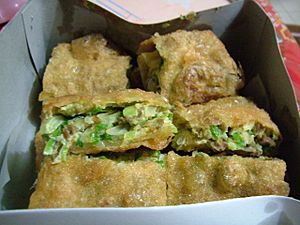
Indian Flavors
Indian influence can be seen in Indonesia as early as the 4th century. When Islam spread to Indonesia, Muslim Indian and Arab influences came into Indonesian cooking. Examples include Indian martabak and kari (curry), which influenced Sumatran foods in Aceh, Minangkabau, and Malay areas. Some Aceh and Minangkabau dishes like roti cane, nasi biryani, nasi kebuli, and gulai kambing (goat curry) have Indian origins.
Chinese Flavors

Chinese immigration to Indonesia started in the 7th century and increased during Dutch colonial times. This created a mix of Chinese and Indonesian cooking styles. Similar Chinese-native fusion food is also seen in Malaysia and Singapore as peranakan cuisine. Some popular Indonesian dishes with Chinese influences include bakmi (noodles), bakso (meatballs), soto mie (noodle soup), soto (soup), bakpao (steamed buns), nasi goreng (fried rice), mie goreng (fried noodles), tahu goreng (fried tofu), siomay (steamed fish dumplings), pempek (fish cakes), lumpia (spring rolls), nasi tim (steamed chicken rice), cap cai (stir-fried vegetables), and fu yung hai (omelette). Many of these Chinese-influenced dishes are now so much a part of Indonesian cooking that many Indonesians don't even realize they came from China.
Dutch Flavors
The Dutch arrived in Indonesia in the 16th century looking for spices. When the Dutch East India Company went bankrupt in 1800, Indonesia became a valuable colony of the Netherlands. Through colonialism, Europeans introduced bread, cheese, barbecued steak, and pancakes. Bread, butter, margarine, sandwiches, poffertjes (small pancakes), pannekoek (pancakes), and Dutch cheeses were commonly eaten by Dutch colonists. Some wealthy Indonesians also learned about European food. This led to European food mixing with Indonesian cuisine. Some dishes created during this time were influenced by Dutch cuisine, including roti bakar (grilled bread), selat solo (Solo salad), macaroni schotel (macaroni casserole), pastel tutup (Shepherd's pie), bistik jawa (Javanese beef steak), semur (from Dutch smoor), and sop buntut (oxtail soup).
Many pastries, cakes, and cookies like kue bolu (tart), lapis legit (spekkoek), and kaasstengels (cheese sticks) come from Dutch influence. Some recipes were invented as Dutch Indies fusion food, using local ingredients but European baking techniques. These include pandan cake and klappertaart (coconut tart). Kue cubit, a popular snack, is believed to come from poffertjes.
Indonesian Food Around the World
Malaysia: Close Culinary Ties
Because they are close, have historical migrations, and share cultural ties, Indonesian food has also influenced neighboring cooking traditions, especially Malaysian cuisine. Indonesian influence is strong in the Malaysian state of Negeri Sembilan. This area was settled mostly by Minangkabau people from West Sumatra. So, their culture and food reflect this. Minangkabau cuisine has deeply influenced Malay cooking. As a result, both traditions share dishes like rendang, gulai, asam pedas, and tempoyak. Rendang is a good example that is now fully part of mainstream Malaysian cuisine and is popular during Hari Raya Aidil Fitri. In the early 20th century, many Sumatrans moved to Kuala Lumpur and other parts of Malaysia. This led to the popularity of Nasi Padang (from Padang city, West Sumatra) not only in Malaysia but also in Singapore.
The Malay cuisine of Johor, Malaysia's southernmost state, shows influences from Javanese who settled there over the past two centuries. Popular Javanese-origin dishes in Johor include ayam penyet (smashed fried chicken), nasi ambeng (rice with side dishes), sayur lodeh (vegetable soup with coconut milk), and pechal (vegetable salad with peanut sauce).
Thailand: A Hint of Indonesia
To a lesser extent, Indonesian food has also influenced Thai cuisine, probably through Malaysia. An example is the introduction of satay, which traveled from Java to Sumatra, the Malay Peninsula, and then to Thailand. Achat, a Thai pickle, is believed to come from Indonesian acar. It's made with cucumber, red chilies, red onions, vinegar, sugar, and salt. It's served as a side dish with the Thai version of satay.
Netherlands: A Taste of the Tropics
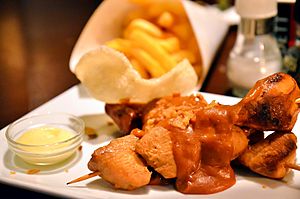
During the colonial period, the Dutch enjoyed Indonesian food both in Indonesia and back home. Indonesian cuisine influenced Dutch colonists and Indo people (people of mixed Dutch and Indonesian heritage). They brought Indonesian dishes back to the Netherlands after Indonesia gained independence.
C. Countess van Limburg Stirum wrote in her book "The Art of Dutch Cooking" (1962): "There exist countless Indonesian dishes... but a few easy ones have become so popular that they can be regarded as 'national dishes'." She then gave recipes for nasi goreng (fried rice), pisang goreng (fried bananas), lumpia goreng (fried spring rolls), bami (fried noodles), satay (grilled skewered meat), satay sauce (peanut sauce), and sambal oelek (chili paste).
Dutch-Indonesian fusion dishes also exist, the most famous being the rijsttafel ("rice table"). This is a fancy meal with many (sometimes dozens) of small dishes. While popular in the Netherlands, rijsttafel is now rare in Indonesia itself. Today, there are many Indonesian restaurants in the Netherlands, especially in big cities like Amsterdam and The Hague.
Culinary Diplomacy: Sharing Indonesian Flavors
Indonesian cuisine has always been popular in neighboring countries like Malaysia, Singapore, and Australia. It's also liked in countries with historical ties to Indonesia, such as the Netherlands, Suriname, and South Africa. It's becoming more popular in Japan and Korea too.
Learning from the success of other countries' culinary diplomacy, like Thailand, Korea, and Japan, Indonesia launched the "Indonesia Spice Up The World" program in 2021. This program aims to promote Indonesian cuisine abroad. It helps local spice products and processed foods reach the global market. It also helps Indonesian restaurants in other countries.
The program involves government groups, the Indonesian food industry, and the public. Its goal is to increase the export value of Indonesian spices and herbs to US$2 billion and to have four thousand Indonesian restaurants abroad by 2024.
Meal Times in Indonesia
Indonesians might eat snacks or small dishes throughout the day. If they have separate, larger meals, they usually include sarapan or makan pagi (breakfast), makan siang (lunch), which is often the main meal, followed by makan malam (dinner). Mealtime is usually casual and can be different in various regions.
In western and central Indonesia, the main meal is usually cooked in the late morning and eaten around midday. In many families, there isn't a set meal time when everyone eats together. So, most dishes are made to stay good even if left at room temperature for many hours. The same dishes are then reheated for the evening meal. Most meals are built around a cone-shaped pile of rice. A meal might include a soup, salad (or sautéed vegetables), and another main dish. Whatever the meal, it always comes with at least one, and often several, chili sauces called sambals. Especially for Javanese families, it's common to always have chips, like kerupuk or rempeyek, to go with the meal.
In eastern Indonesia, like on the islands of Papua and Timor, the climate is often much drier. Meals there might focus on other main foods like sago or starchy tubers. Because these islands are east of the Wallace Line, the plants and animals are quite different from those in the west, so the foods are different too.
Feasts and Special Meals
Tumpeng: A Mountain of Food
Many Indonesian traditions and ceremonies include food and feasts. One of the best examples is tumpeng. It's originally from Java and is a cone-shaped mound of rice surrounded by various other dishes. It was officially chosen as an Indonesian national dish in 2014. Traditionally, it's part of slametan ceremonies. The rice cone is made using bamboo leaves woven into a cone shape. The rice itself can be plain white steamed rice, uduk (rice cooked with coconut milk), or yellow rice (rice colored with turmeric).
After being shaped, the rice cone is surrounded by dishes like urap vegetables, fried chicken, semur (beef in sweet soy sauce), teri kacang (dried fish with peanuts), fried prawns, telur pindang (marbleized boiled eggs), shredded omelette, tempe orek (sweet, dry fried tempeh), perkedel kentang (mashed potato fritters), perkedel jagung (corn fritters), sambal goreng ati (liver in chili sauce), and many others. Nasi tumpeng probably comes from an ancient Indonesian tradition that saw mountains as the home of ancestors and gods. The rice cone symbolizes a holy mountain. This feast is a way of giving thanks for a good harvest or other blessings. Because it's so festive, tumpeng is sometimes used like a birthday cake in Indonesia today.
Nasi Padang: A Table Full of Choices
Having Nasi Padang in the festive hidang (serve) style lets you try many Padang foods at once. Nasi Padang (Padang-style rice) is steamed rice served with many pre-cooked dishes from Padang city, West Sumatra. It's like a mini-banquet of meats, fish, vegetables, and spicy sambals eaten with plain white rice. It's a great gift from the Minangkabau people to Indonesian cuisine.
When customers sit down, they don't have to order. Waiters bring stacked plates of dishes directly to the table. The table quickly fills with dozens of small dishes. These include richly flavored foods like beef rendang, various gulais, curried fish, stewed greens, chili eggplant, curried beef liver, fried chicken, and of course, sambal. A dozen dishes is normal, and sometimes there are 14 or more. Nasi Padang is an at-your-table buffet. Customers only pay for what they eat from this array.
Prasmanan: The Indonesian Buffet
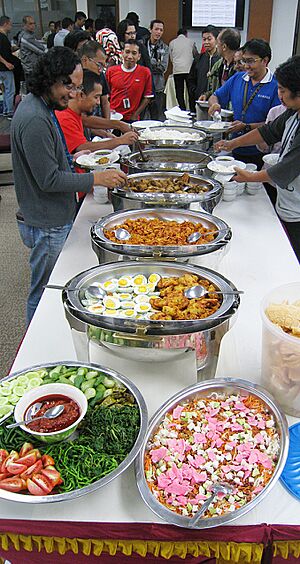
When you go to an Indonesian traditional wedding party, an office lunch, a seminar, or a dinner gathering, you'll often find yourself lining up for an Indonesian prasmanan. This is a long table filled with many Indonesian dishes. A prasmanan is similar to a rijsttafel but without the ceremonial waiters and usually with fewer dish choices. It's an Indonesian buffet with a wide range of savory and sweet dishes. It's usually found at wedding ceremonies or other celebrations. The setup for a wedding buffet usually has plates, eating tools (spoon and fork), and napkins at one end. Then comes rice (plain or fried), a series of Indonesian (and sometimes international) dishes, sambal, and krupuk (shrimp crackers). At the other end, there are glasses of water.
Drinks in Indonesia
Non-Alcoholic Drinks
The most common and popular Indonesian drinks are teh (tea) and kopi (coffee). Indonesian homes usually serve teh manis (sweet tea) or kopi tubruk (coffee mixed with sugar and hot water, poured directly into the glass with coffee grounds) to guests. Since the Dutch colonial era, plantations in Java were major producers of coffee, tea, and sugar. Since then, hot and sweet coffee and tea have been enjoyed by Indonesians. Jasmine tea is the most popular tea in Indonesia, but green tea is becoming popular due to health awareness. Coffee and tea are usually served hot, but cold iced sweet tea is also common. Kopi luwak is an exotic and expensive Indonesian coffee made from beans eaten and passed by the Asian palm civet. Teh botol, bottled sweet jasmine tea, is very popular and competes with international sodas like Coca-Cola. Kopi susu (coffee with sweetened condensed milk) is Indonesia's version of Café au lait. Es kelapa muda (young coconut ice) is a refreshing drink made from chilled young coconut water, coconut flesh, and syrup. It's a favorite in Indonesia.
Fruit juices (jus) are very popular. Varieties include orange (jus jeruk), guava (jus jambu), mango (jus mangga), soursop (jus sirsak), and avocado (jus alpokat). Avocado juice is often served with condensed milk and chocolate syrup, like a dessert. Durian can be made into ice cream called es durian.
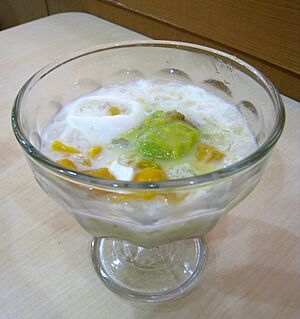
Many popular drinks are ice-based (es) and can also be considered desserts. Examples include young coconut (es kelapa muda), grass jelly (es cincau), cendol (es cendol or es dawet), avocado, jackfruit, and coconut with shredded ice and condensed milk (es teler), mixed ice (es campur), kidney beans (es kacang merah), and seaweed (es rumput laut).
Hot sweet drinks are also found, like bajigur and bandrek, which are popular in West Java. Both are hot drinks made with coconut milk or coconut sugar (gula jawa) and other spices. Sekoteng, a ginger-based hot drink with peanuts, diced bread, and pacar cina, is found in Jakarta and West Java. Wedang jahe (hot ginger drink) and wedang ronde (a hot drink with sweet potato balls) are popular in Yogyakarta, Central Java, and East Java.
Alcoholic Drinks
As a country with a Muslim majority, Indonesian Muslims follow Islamic dietary laws that forbid alcoholic drinks. However, local alcoholic drinks were developed in the islands long ago. An old Chinese source says that people in ancient Java drank wine made from palm sap called tuak (palm wine). Today, tuak is still popular in the Batak region of North Sumatra. A traditional Batak bar serving tuak is called a lapo tuak. In Solo, Central Java, ciu (a local version of Chinese wine) is known. Bottled brem bali (Balinese rice wine) is popular in Bali. In Nusa Tenggara and Maluku Islands, people also drink palm wine, called sopi. In the Minahasa region of North Sulawesi, people drink a strong alcoholic drink called Cap Tikus. Indonesians also have local beer brands like Bintang Beer and Anker Beer.
Where to Eat in Indonesia
In Indonesia, you can find dishes everywhere: from fancy restaurants in five-star hotels, to simple downtown restaurants, to humble street-side warung under tents, and even street hawkers pushing their gerobak (carts) or carrying food on a pikulan (carrying pole).
Restaurants and Warung
In Indonesia, rumah makan means restaurant, while warung means a small, humble shop. Among these, warteg (warung Tegal) and rumah makan Padang are especially common in Indonesian cities and towns.
A warteg or warung tegal is a specific type of warung nasi (rice stall). It's run by Javanese people from the town Tegal in Central Java. They sell popular Javanese dishes and rice. The many pre-cooked dishes are displayed in a glass cabinet. They are known for selling affordable meals, popular among working-class people in cities. A rumah makan Padang is a Padang restaurant. Smaller Padang eateries might be called warung Padang.
Most Indonesian restaurants specialize in a certain regional food. For example, rumah makan Padang serves Minangkabau cuisine. Sundanese saung restaurants, also called kuring restaurants, sell Sundanese dishes. This also includes Bataks' lapo, Manado and Balinese restaurants. Other restaurants might focus on their best specific dishes, like Ayam goreng Mbok Berek or Satay Senayan.
Street Food: Delicious and Affordable
Indonesian street food is usually cheap, offers a great variety of tastes, and can be found on every corner of the city. Street vendors are common. Some push their goods on bicycles or carts. These carts are known as pedagang kaki lima. These food hawkers might travel on streets, calling out to potential buyers in neighborhoods. Or they might set up a simple seating area under a small tent on a busy street side, waiting for customers. Many have their own special call, tune, or noise to announce their presence. For example, bakso sellers hit the side of a soup bowl with a spoon, while nasi goreng sellers hit their wok.

In most cities, you'll see Chinese dishes like bakpao (steamed buns), bakmie (noodles), and bakso (meatballs) sold by street vendors and restaurants. These are often adapted to become Indonesian-Chinese food. One common change is that pork is rarely used, as most Indonesians are Muslims. Other popular Indonesian street foods and snacks are siomay (steamed fish dumplings) and batagor (fried fish dumplings), pempek (fried fish cakes), bubur ayam (chicken congee), bubur kacang hijau (mung bean porridge), satay, nasi goreng (fried rice), soto mie (soto noodle), mie ayam (chicken noodle), mie goreng (fried noodle), taoge goreng (mung bean sprouts and noodle salad), asinan (pickled vegetables or fruits), laksa, kerak telor (spicy omelette), and gorengan (Indonesian assorted fritters).
Indonesian street snacks also include iced and sweet drinks, like es cendol, es teler, es cincau, es doger, es campur, and es puter. Indonesian cakes and cookies are often called jajanan pasar (market munchies).
Snacks: Sweet and Savory Bites
Kue: Traditional Cakes and Pastries
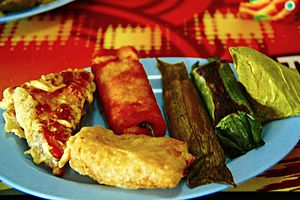
Indonesia has many different snacks called kue (cakes and pastries), both savory and sweet. Traditional kue are usually made from rice flour, coconut milk, and coconut sugar. They are mostly steamed or fried, not baked. Traditional kue are known as kue basah ("wet kue") because they are moist and soft from the rich coconut milk. Kue kering ("dried kue") is the local name for cookies.
Indonesia has many types of kue, both native and foreign-influenced. Popular ones include Bika Ambon, kue pisang, kue cubit, klepon, onde-onde, nagasari, kue pandan, lupis, lemang, lemper, lontong, tahu isi, getuk, risoles, pastel, lumpia, bakpia, lapis legit, soes, poffertjes, and bolu kukus.
Traditional Crackers: Crunchy Companions

Traditional crackers are called krupuk. They are made from bits of shrimp, fish, vegetables, or nuts. They are usually eaten as a crunchy snack or with main meals. These crispy snacks are sometimes added to main meals for a crunchy texture. Several Indonesian dishes like gado-gado, karedok, ketoprak, lontong sayur, nasi uduk, asinan, and bubur ayam need specific types of krupuk as toppings. There are many types of krupuk in Indonesia. The most popular are krupuk udang (prawn crackers) and krupuk kampung or krupuk putih (cassava crackers).
Other popular types include krupuk kulit (dried buffalo-skin crackers), emping melinjo (gnetum gnemon crackers), and kripik (chips or crisps). Examples are kripik pisang (banana chips) and keripik singkong (cassava chips). Rempeyek is a flour-based cracker with peanuts, anchovies, or shrimp. Rengginang or intip (Javanese) is a rice cracker made from sun-dried and deep-fried leftover rice.
Fruits: Tropical Delights
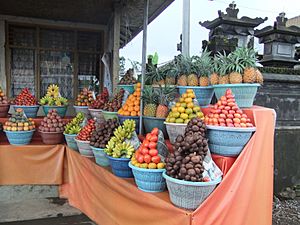
Indonesian markets are full of many types of tropical fruit. These are an important part of the Indonesian diet. They are eaten fresh, or made into juices (like jus alpukat - avocado juice), desserts (like es buah - fruit ice, and es teler), or processed into savory and spicy dishes like rujak. They are also fried like pisang goreng (fried banana), cooked into cakes (like kue pisang or bika ambon), sweetened and preserved like sale pisang and manisan buah, or made into kripik (crispy chips) like jackfruit or banana chips.
Many of these tropical fruits are native to the Indonesian archipelago. These include mangga (mango), manggis (mangosteen), rambutan, cempedak, nangka (jackfruit), durian, jambu air, duku (langsat), jeruk bali (pomelo), belimbing (carambola), kedondong, and pisang (banana). Other fruits were brought from other tropical countries, though their exact origins might be debated. Klengkeng (longan) came from India. Semangka (watermelon) came from Africa. Kesemek came from China. Alpukat (avocado), sawo, markisa (passionfruit), sirsak (soursop), nanas (pineapple), jambu biji (guava), and pepaya (papaya) came from the Americas. Many tropical fruits are available only during certain seasons, depending on when they flower and fruit. But some, like banana, watermelon, pineapple, and papaya, are available all year.
Today, Indonesian markets also have non-tropical fruits that are grown locally. Strawberry, melon, apple, pear, and dragonfruit are grown in cooler Indonesian highlands, like Malang in East Java, and Puncak and Lembang near Bandung.
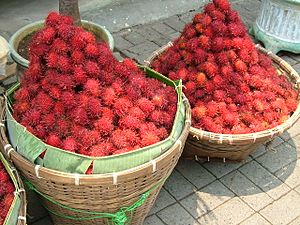
In recent years, fruit chips have become more diverse. Before, banana and jackfruit chips were most common. But now, Indonesian fruit chips are also made from strawberry, apple, dragonfruit, pepino, watermelon, and melon. Malang, a city in East Java, is a center for fruit chip production, along with tempeh chips.
Bananas and coconuts are especially important, not just for Indonesian food, but also for other uses. These include timber, bedding, roofing, oil, plates, and packaging. Banana leaf and janur (young coconut leaf) are very important for packaging and cooking, used to make pepes, lontong, and ketupat.
See also
 In Spanish: Gastronomía de Indonesia para niños
In Spanish: Gastronomía de Indonesia para niños



